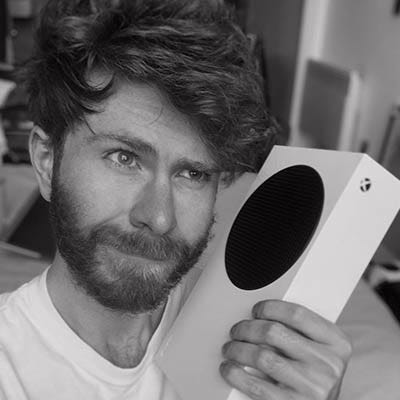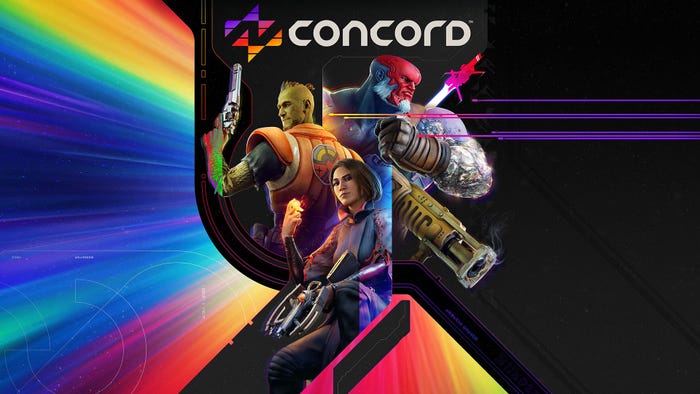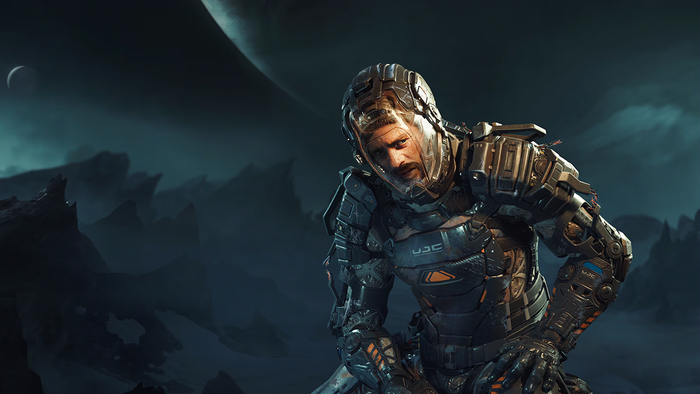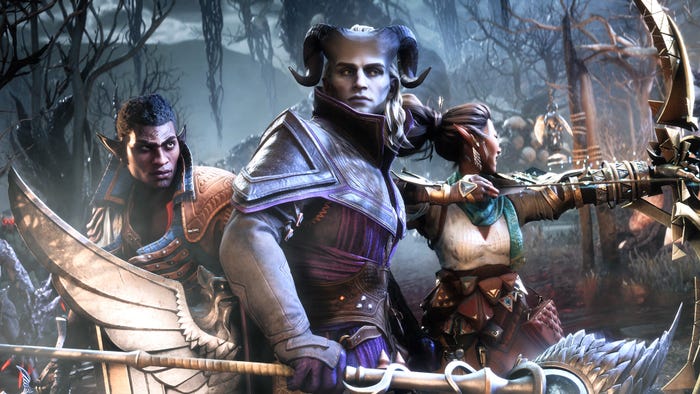Honing the virtual reality swordplay of PvP dueler Broken Edge
Game director Guillaume Perreault-Roy explains how Trebuchet built and enhanced the blade-shattering combat systems behind its VR fantasy fighter.

Nailing the feel of sword combat in the VR arena isn't easy, but that's precisely what Trebuchet set out to do with the launch of its swashbuckling fantasy fighter Broken Edge. The multiplayer dueling game launched in November 2022 for platforms including SteamVR and Meta Quest 2, but has now debuted on the PS VR2.
In the vibrant world of Broken Edge, swordplay is designed to be an exhilarating, tactical affair that harks back to some of the most iconic skirmishes to have graced the silver screen. Players must prove their prowess by mastering the unique techniques and powers of historical warriors like samurai, pirates, and knights to best their opponents in tense PvP combat.
The studio designed its combat system to nullify what it calls "hyper-speed movements" such as wiggling. Instead, the team focused on allowing players to swing their sword freely to encourage precise, deliberate movements. With the right strategy, it's possible to eliminate foes in a single blow, but players might also find themselves on the end of a similarly fatal strike if they misjudge their enemy.
It's a high-stakes dance built on a combat system that Trebuchet hopes will accommodate newcomers and veterans alike. Intrigued by the studio's approach to swordplay and how it has been accentuated for PS VR2 players, we caught up with Broken Edge game director Guillaume Perreault-Roy to discuss how you build a VR fighter that shines.
Game Developer: Could you outline the core design pillars you leaned on when building your combat system and refining it for PS VR2?
Guillaume Perreault-Roy: Our initial goal was to replicate a satisfying, skill-based blade clash. As our project evolved, we decided to base its dynamics more on fantasy, resembling epic sword fights seen in movies and games, rather than strict simulation. Simultaneously, we determined that the gameplay should closely mimic actual martial arts techniques. Our approach involved implementing practical solutions to overcome the limitations of VR, allowing players the freedom of movement. Consequently, players could blend optimal biomechanics with a high level of class-based roleplay, a combination that exceeded our initial expectations.
Throughout the development process, we maintained a strong focus on promoting a risk-reward system to foster the creation of a rich meta centered around feints and reads. Lately, we gained access to the PS VR2 haptics, enabling us to provide improved and more impactful feedback to players.
What were some of the biggest technical challenges of developing a combat system–specifically one built around fencing–for the VR space?
I would like to highlight two challenging technical aspects that we've had to address in our game development journey:
First and foremost, given that our game relies on capturing real movements as inputs, we've had to compose with the performative nature of the human body. Especially in a competitive gaming environment, players seek to optimize their gameplay, resulting in very rapid movements. However, latency becomes a big issue at those speeds, leading to variations in collisions within each player's game instance. To tackle these challenges, we employed a combination of perceptual and game design tools. We incentivized deliberate, well-thought-out movements over twitchy and excessively rapid actions. This approach allowed us to create distinct, class-based gameplay experiences that place a strong emphasis on roleplay.
In Broken Edge, adopting fighting movements that are "readable" or "reactable" to opponents has proven to be a game-changer. We've discovered that the introduction of "shadow-collisions" (a translucent representation of blade clashes) serves as a great feedback mechanism for evaluating both players' performance. These "shadow-collisions" manifest where the collision occurred within each player's instance, ensuring coherence. However, the depth of blade clash (how deeply the blades are cut, a critical aspect of the battle) is determined as an average result derived from both players' instances.
Furthermore, since sword fighting in Broken Edge closely mimics real martial arts, players are in a constant state of reaction to each other's movements. In this dynamic context, latency effectively acts as a "millisecond fog of war." The opponent's reaction time is perpetually influenced by the latency, which serves to amplify the importance of feints and reads within the game's meta.
How did you layer in tactical depth in a way that accommodated newcomers while allowing more experienced players to finesse their style?
Our concept revolved around implementing layers of techniques with varying degrees of complexity. Players have the option to play instinctively with fundamental notions, but also have the opportunity to progressively acquire more advanced techniques, each offering deep strategic advantages.
To begin, we introduced the notion that touching your opponent's body results in an instant kill. You have to target the body and protect yours. The second notion is the concept that blades are cut at the point of impact. Slicing an opponent deeply will deplete their resources, creating a strategic imperative to attack the opponent's blade while protecting yours. Newcomers can focus on mastering these two fundamental principles, allowing them to engage in competitive gameplay effectively.
However, the real depth of our game emerges when players delve into the "Awaken" system, which is class-based and rewards skillful play. Learning a class's Awaken style, its unique blade arts, and mastering the use of secondary blades leads to a significant elevation in a player's competitive capabilities. While executing these advanced techniques is a crucial step, they also unlock a complex meta of feints and strategies, providing players with a lengthy and rich progression journey.

What considerations unique to VR development did you take into account when conceptualizing and tweaking combat?
PvP melee combat in VR holds great promise—the prospect of engaging in virtual fights with other players and real movements is truly exciting. However, there are very few games that propose that. There are significant challenges that must be overcome to deliver a satisfying gameplay experience. We identify two primary hurdles that need to be addressed to unlock the full potential of PvP melee combat in VR, from our point of view:
The first challenge revolves around what we term "one-way physics." In the VR environment, everything can respond to your actions, but we cannot impose movements on you as the avatar. It's a basic practice of traditional video games that we can't use since the player IS the avatar. To work around this limitation, we introduced the blade-cutting mechanic in Broken Edge. This approach ensures that energy blades break at the point of impact, generating a powerful energy backlash that separates the players. This mechanic serves multiple purposes: it provides a clear and understandable behavior (blades being cut), conveys visceral consequences (fighting with a half-blade feels vulnerable), emphasizes skill and precision (both blades being cut simultaneously), and offers a brief moment of reflection as players are pushed apart. Most importantly, it circumvents the need to simulate the physical clash of blades, a challenge posed by "one-way physics." Our focus was on creating the "satisfaction of the clash" rather than attempting to simulate it.
The second challenge is related to movement in VR. We are big fans of the roomscale model and its immersion potential. Sword Fighting in VR usually involves flailing a sword while moving with the joystick. We always felt that biomechanics and "joystick movement" meshed poorly in VR. Additionally, moving in-and-out of range (spacing) is a critical component of sword fighting. Real-life movements are so precise, we didn't want to layer approximative directional inputs over it. As mentioned earlier, when players' energy blades clash, they are pushed out of range by an energy backlash and then gradually move forward, a cycle we refer to as "engagement." To maintain the player's playspace coherency during these movements, we introduced the concept of "Mirror movement." From each player's perspective, it appears as if their opponent is pushed back by the energy clash and subsequently closes the gap. This mirrored perspective allows for intricate strikes and footwork, transforming Broken Edge into a virtual martial art that embraces real-life movements, all while enhancing player immersion.

What similarities does the final iteration of combat have in common with your earliest prototypes and how do they differ?
I would say that the similarities are the freedom of movement and the capacity to counter the opponent if you predict its attacks. However, the significant difference is the expansion of gameplay elements and situations. We've created diverse gameplay options to ensure that every duel has its unique arc, resulting in a rich meta. Players are constantly presented with various resources and strategic choices, such as their main blade and its regrowth power, one-time use secondary weapons, and choreography-based blade arts. These tools, along with their depletion, give rise to a multitude of game situations and strategic possibilities, creating a crescendo of escalating stakes that make duels intense pressure-cookers.
The introduction of classes in the game's Awaken mechanic (each fighter has their own Awaken style) allowed us to delve deeper into martial styles, emphasizing mastery and roleplay. Each class features distinct loadouts, strengths, weaknesses, and unique powers, encouraging players to embody their chosen class's sword-fighting style. A significant evolution from the early prototype lies in the balance between strategies. Players can choose between exhausting their opponent's resources through favorable clashes (over-performing) or taking risky one-strike victories that come with their own set of challenges. In both cases, risk-taking, feinting, and reading the opponent are rewarded, adding depth and excitement to the gameplay.
I'm always curious to know how you add an appropriate sense of weight to swords and shields in VR titles. How did you hit the sweet spot?
We've taken a rather unconventional approach to this aspect. Instead of following the common simulation route, where weight is simulated by causing swords to drag more or less in response to your movements, we've opted for a different model. While this weight compensation is quite convincing in a vacuum, we believe it has limitations. Since it's based on a difference between the position of your real and virtual hands, it's a compromise that breaks coherency: the faster you move, the further your virtual hand is from your real hand. Speed, force and weight all rely on a desynchronization between the real and the virtual. Our model is based on reinforcement: when you effectively roleplay the weight of your sword, it becomes "powered-up" through our Awaken mechanics. This model preserves coherency and offers a greater degree of freedom.
Our thinking has been influenced by the observation of many VR games characterized by frantic, rushed, and imprecise movements, often resulting in what can be described as "wiggle gameplay." Conversely, games like Superhot grant players the freedom to choose their movement speed but reward them with extraordinary abilities when they move in slow-motion. Our development process has focused on reinforcing deliberate movements infused with roleplay. The more you embody the characteristics of the class you've chosen, the more potent your sword becomes.
One significant advantage of our approach is that it counters a tendency we've noticed in VR games. Typically, players start with a healthy dose of roleplay but gradually shift towards efficient but repetitive movements. In Broken Edge, however, the more you play, the deeper you become immersed in roleplay. Another essential benefit is that by empowering composed movements, we ensure that your opponent's strikes are readable and engaging, as opposed to the nervous and erratic gameplay often encountered in VR. This approach fosters gameplay that's fun to play against.
Our journey to finding the perfect balance has revolved around three key elements for competitive gameplay: infusing a roleplay-rich martial style that enhances sword power, incorporating optimal biomechanical movement, and introducing unpredictability (as predictability is severely penalized in Broken Edge). This equilibrium between style and freedom of movement promotes creativity and ensures that every battle is a unique and engaging experience.

What was the single most important lesson you learned designing the combat system in Broken Edge?
Anticipating player behavior and assessing the effectiveness of game mechanics is a vital process. It plays a crucial role in early development phases, helping us avoid significant issues and increasing our overall chances of success. However, the volume of discoveries is always impressive! These revelations can range from unexpected elements that catch us by surprise to aspects that prove to be far more pivotal than we initially realized.
Players will optimize every mechanic you give them, further than you'd believe. We believe that our player community serves as invaluable partners in our game's development process. At times, it feels as though we are the engineers crafting the experience while they are the racecar drivers, measuring the impact of the new features and adjustments in a high-pressure, competitive context. Without their valuable feedback and insights, we could never have brought Broken Edge to its current state of refinement and success.
Read more about:
FeaturesAbout the Author
You May Also Like








.png?width=700&auto=webp&quality=80&disable=upscale)
.png?width=700&auto=webp&quality=80&disable=upscale)